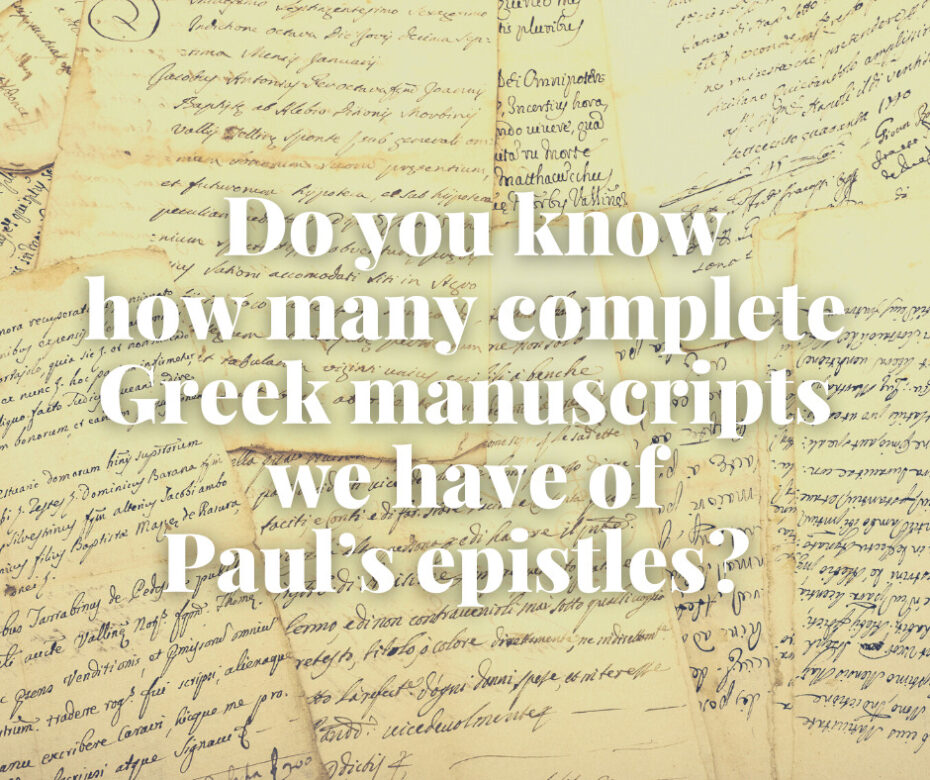It has been well publicized that there are over 5,000 Greek manuscripts of the NT. The manuscripts we have today were created between AD 125 and AD 1516. Scribes copied by hand the books of the NT. The first copies were made directly from the original manuscripts. Then those copies were copied.
The number of available copied manuscripts has grown as new copies are discovered every year. It is now commonly reported that there are about 5,800 manuscripts of the NT. In addition, there are 10,000 ancient Latin manuscripts (translations of the early Greek manuscripts) and 9,300 ancient manuscripts in other languages (e.g., Coptic, Syriac, Ethiopic). And the church fathers quoted nearly every verse in the NT in their writings.
The time between the writing of the original manuscripts of the NT and their earliest copies is between 100 and 200 years. Compare that to other major works of antiquity, whose earliest copies date to over 1,000 years after the books were written.
One fact that has not been published widely is the number of individual books for which we have complete Greek manuscripts. We do not have 5,800 complete manuscripts of any book in the NT. Many manuscripts–such as the Gospels or Paul’s letters–contain only a portion of the book.
I asked Dr. Wilbur Pickering, an expert on the text of the NT, how many manuscripts we have for the various portions of the NT. Here is his answer:
There are around 2,000 manuscripts (MSS) containing the Gospels; because of fragments and lacunae, for any given verse (e.g., John 3:16) there are around 1,700.
There are around 800 MSS containing the Pauline corpus.
There are around 650 MSS containing Acts.
There are around 600 MSS containing the General Epistles.
There are around 300 MSS containing the Apocalypse.i
While that is not as impressive as if there were 5,800 manuscripts of every verse in the NT,ii we still see the hand of God in the NT copying process when we contrast the number of NT manuscripts with the numbers of these best-known books of antiquity:
| Author | Between writing & 1st copy | # of MSS |
| Plato | 1,200 years | 7 |
| Caesar | 1,000 years | 10 |
| Herodotus | 1,300 years | 8 |
| Thucydides | 1,300 years | 8 |
| Aristotle | 1,400 years | 49 |
| Josephus | 1,000 years | 120 |
| Homer (Iliad) | 500 years | 643 |
| Gospels | Less than 100 yearsiii | 1700 |
| Paul’s letters | 110-150 | 800 |
| Acts | 200 years | 650 |
| General epistles | 150-200 years | 600 |
| Revelation | 150-200 years | 300iv |
Homer’s works are the only attested writings of antiquity whose numbers are even close to the number of NT books. All the other writings have only a handful of manuscripts, and each of these is separated from its original by over a millennium.
When we compare the NT manuscripts with each other, we see that the scribes were extremely accurate in their copying, especially in the Byzantine region, from which the vast majority of manuscripts have come.
It should be noted that the date of a NT manuscript does not indicate its reliability. The earliest manuscripts do not evidence the greatest care in copying. The later manuscripts do. The key is not the date of the manuscript, but the date of the manuscript from which it was copied and how carefully it was copied.
We don’t know how long the original manuscripts, or the first copies of the originals, lasted. It is speculated that the originals lasted 100 to 150 years because they would have been much used, yet treated with great care (see here). The first generation of copies probably lasted several centuries, though they could have lasted for over a thousand years as evidenced by the fact that we have manuscripts from the second, third, and fourth centuries today.
A ninth-century manuscript might have faithfully copied a third-century manuscript that had faithfully copied the original book. If so, it accurately represents a very early witness. Andrews says, “The New Testament scholars of today…would go on to tell you that a 9th-century manuscript might have fewer copies in between than a 3rd-century manuscript” (see here).
God not only inspired the 27 books of the NT (and the 39 books of the OT), but He also supernaturally saw to it that the text of His Word was copied faithfully and often.
_________
i Personal correspondence (email) from Dr. Pickering on December 25, 2022.
ii When we add in the thousands of ancient translations of each book, the evidence is overwhelming.
iii There is a fragment of John’s Gospel that is dated around AD 125. In terms of complete manuscripts of the Gospels, the gap is around 150 years.
iv This information is gathered from various online articles as well as several Wikipedia articles.


